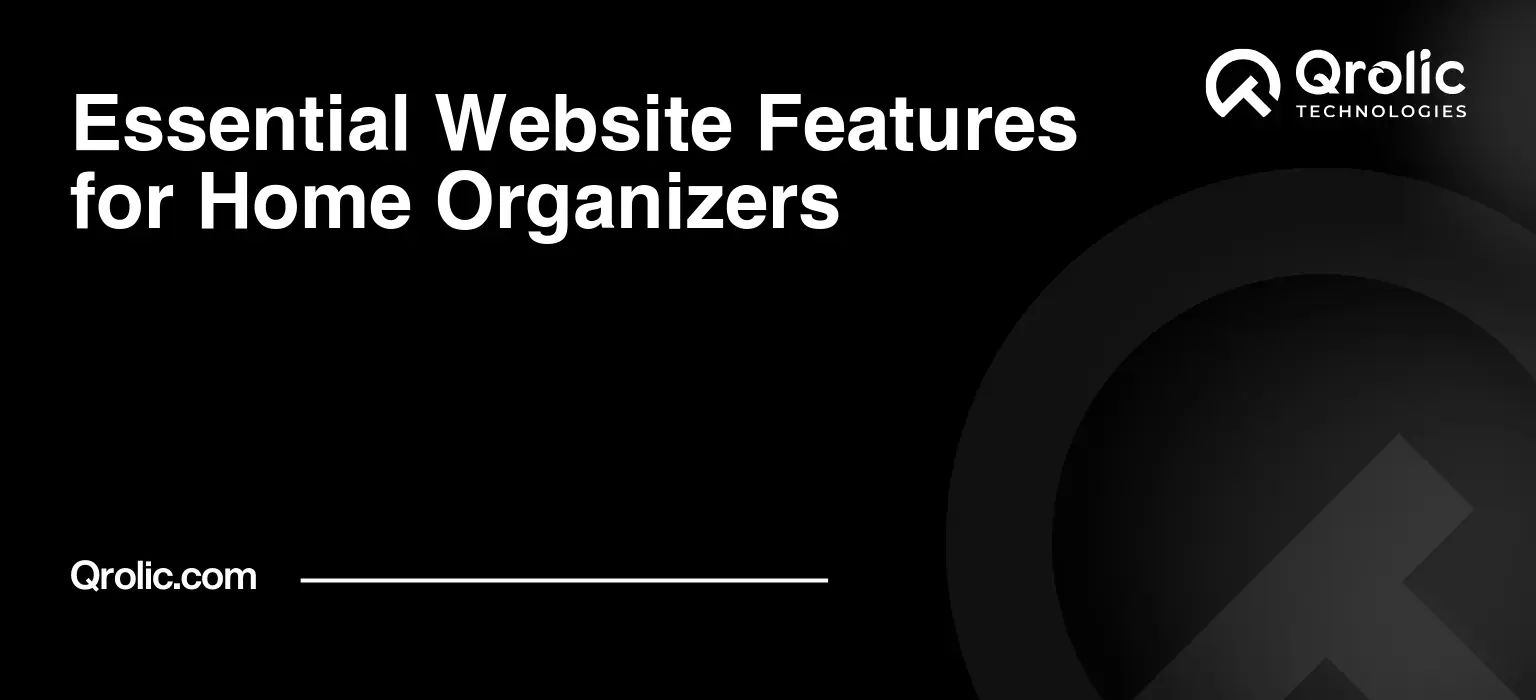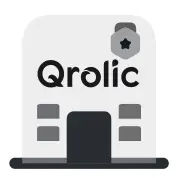Quick Summary:
- A strong website attracts ideal home organizing clients.
- Showcase your services, projects, and client success.
- Make booking and payments easy for clients.
- Keep your website secure, fresh, and optimized.
Table of Contents
- The Untapped Potential of a Powerful Website for Home Organizers
- Why a Dedicated Website is Non-Negotiable for Home Organizers
- I. Attracting Your Ideal Client: The Foundation of a Great Website
- A. Understanding Your Target Audience
- B. Compelling Website Design: First Impressions Matter
- C. Search Engine Optimization (SEO): Getting Found Online
- II. Showcasing Your Expertise: Building Trust and Authority
- A. Detailed Service Pages: Clearly Define Your Offerings
- B. Project Showcase: Visual Proof of Your Success
- C. Client Testimonials: Social Proof that Converts
- D. About Us Page: Connect on a Personal Level
- E. Blog and Resources: Providing Value and Establishing Expertise
- III. Streamlining Client Interactions: Efficiency and Convenience
- A. Contact Form: Making it Easy to Reach You
- B. Online Scheduling: Booking Appointments with Ease
- C. Client Forms: Gathering Information Efficiently
- D. Payment Options: Providing Flexible Payment Methods
- IV. Optimizing for Success: Long-Term Growth and Maintenance
- A. Website Analytics: Tracking Performance and Making Data-Driven Decisions
- B. Mobile Optimization: Catering to On-the-Go Users
- C. Website Security: Protecting Your Data and Your Clients’ Information
- D. Regular Content Updates: Keeping Your Website Fresh and Relevant
- V. Partnering for Success: Qrolic Technologies
- Why Choose Qrolic Technologies?
- Conclusion: Your Website – A Powerful Asset for Growth
The Untapped Potential of a Powerful Website for Home Organizers
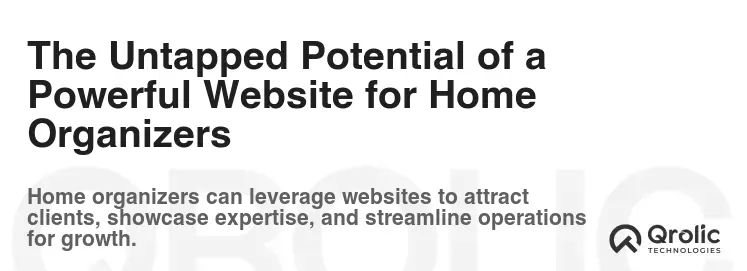
Imagine a world where clutter melts away, stress dissipates, and homes transform into havens of tranquility. As a home organizer, you’re not just tidying spaces; you’re crafting lifestyles. But in today’s digital landscape, your offline brilliance needs a captivating online presence. Your website is more than just a digital brochure; it’s your 24/7 salesperson, your portfolio, your client relationship manager, and your brand ambassador. It’s the cornerstone of your business growth.
Why a Dedicated Website is Non-Negotiable for Home Organizers
Think about it: when someone searches for “home organizer near me,” will they find you? A well-designed website is the difference between being invisible and becoming the go-to expert in your area. It provides credibility, showcases your expertise, and simplifies the client acquisition process. It allows you to communicate your unique value proposition and demonstrate how you can transform lives through organization.
This article delves into the essential website features that will not only attract potential clients but also convert them into loyal, raving fans. We’ll explore everything from impactful design to seamless functionality, ensuring your website becomes a powerful engine for growth.
I. Attracting Your Ideal Client: The Foundation of a Great Website
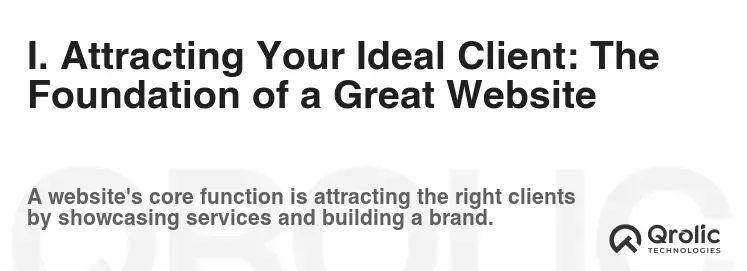
A. Understanding Your Target Audience
Before you even think about design or features, you need to know who you’re trying to reach. Are you targeting busy professionals, families with young children, or seniors downsizing their homes? Each demographic has different needs and preferences, and your website should reflect that.
- Define Your Ideal Client Avatar: Give your ideal client a name, age, profession, and even a personality. What are their pain points related to organization? What are their aspirations? What are they searching for online?
- Conduct Market Research: Analyze your competitors’ websites and identify what they’re doing well (and not so well). Read online reviews to understand what clients appreciate (and dislike) about home organizers.
- Use Analytics: Once your website is live, use tools like Google Analytics to track visitor demographics, interests, and behavior. This data will help you refine your website over time.
B. Compelling Website Design: First Impressions Matter
Your website’s design is your first chance to make a lasting impression. It should be visually appealing, easy to navigate, and aligned with your brand identity.
- Professional Aesthetics: Invest in a clean, modern design that reflects your professionalism. Avoid cluttered layouts, distracting animations, and outdated fonts.
- High-Quality Visuals: Use professional photographs of your work. Before-and-after shots are incredibly powerful for showcasing your transformation abilities.
- Mobile Responsiveness: Ensure your website looks and functions flawlessly on all devices, from smartphones to desktops. Mobile-friendliness is crucial for SEO and user experience.
- Consistent Branding: Use your logo, colors, and fonts consistently throughout your website to create a cohesive brand identity.
- Easy Navigation: Design a clear and intuitive navigation menu that allows visitors to easily find the information they’re looking for.
C. Search Engine Optimization (SEO): Getting Found Online
Having a beautiful website is useless if no one can find it. SEO is the art and science of optimizing your website to rank higher in search engine results.
- Keyword Research: Identify the keywords that your target audience is using to search for home organizers. Examples include “home organizer [city name],” “decluttering services,” and “closet organization.”
- On-Page Optimization: Incorporate your target keywords naturally into your website’s content, including page titles, headings, meta descriptions, and image alt text.
- Content Marketing: Create valuable and informative blog posts, articles, and guides related to home organization. This will attract visitors to your website and establish you as an expert.
- Link Building: Earn high-quality backlinks from other websites in your industry. This will improve your website’s authority and credibility in the eyes of search engines.
- Local SEO: Optimize your website for local search by claiming your Google My Business listing and including your business name, address, and phone number (NAP) on your website.
II. Showcasing Your Expertise: Building Trust and Authority
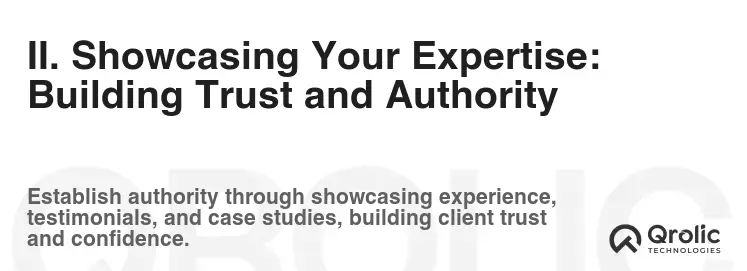
A. Detailed Service Pages: Clearly Define Your Offerings
Each service you offer should have its own dedicated page that explains the benefits, process, and pricing.
- Specific Service Descriptions: Clearly outline what each service entails. For example, instead of just “closet organization,” describe the process: “We’ll start with a complete inventory, then categorize your items, and finally create a functional and aesthetically pleasing closet system.”
- Benefits-Driven Language: Focus on the outcomes your clients will achieve. Instead of saying “We declutter your home,” say “Enjoy a stress-free and clutter-free home that promotes relaxation and productivity.”
- Pricing Transparency: Be upfront about your pricing structure, whether it’s hourly rates, package deals, or custom quotes. This builds trust and saves you time fielding inquiries from clients who can’t afford your services.
- Call to Action: Include a clear call to action on each service page, such as “Schedule a Consultation” or “Get a Free Quote.”
B. Project Showcase: Visual Proof of Your Success
A picture is worth a thousand words, especially when it comes to demonstrating your transformation abilities. A well-curated project showcase is a powerful tool.
- High-Quality Before-and-After Photos: Showcase your best work with stunning before-and-after photos. Make sure the photos are well-lit, high-resolution, and accurately represent the transformation.
- Project Descriptions: Provide context for each project by describing the client’s challenges, your approach, and the results achieved.
- Categorize Projects: Organize your projects by service type (e.g., kitchen organization, home office organization) or by client type (e.g., families, seniors).
- Client Testimonials: Include testimonials from satisfied clients who have benefited from your services.
C. Client Testimonials: Social Proof that Converts
Testimonials are a powerful form of social proof that can significantly impact your conversion rates.
- Gather Authentic Testimonials: Ask your happy clients to provide testimonials about their experience working with you. Be specific about what you’d like them to address, such as the results they achieved, your professionalism, and your communication skills.
- Display Testimonials Prominently: Showcase your testimonials on your homepage, service pages, and even your contact page.
- Use Video Testimonials: Video testimonials are even more impactful than written testimonials. They add a personal touch and allow potential clients to see and hear from real people who have benefited from your services.
- Include Photos with Testimonials: Whenever possible, include a photo of the client alongside their testimonial to add credibility and make it more relatable.
D. About Us Page: Connect on a Personal Level
Your About Us page is your opportunity to connect with potential clients on a personal level and share your story.
- Share Your Story: Explain why you’re passionate about home organization and how you got started in the business.
- Highlight Your Expertise: Showcase your qualifications, certifications, and experience in the field.
- Introduce Your Team: If you have a team, introduce each member and highlight their skills and expertise.
- Show Your Personality: Let your personality shine through! Use a friendly and approachable tone of voice that reflects your brand.
- Include a Photo: Include a professional photo of yourself and your team.
E. Blog and Resources: Providing Value and Establishing Expertise
A blog is a powerful tool for attracting new visitors to your website, establishing yourself as an expert, and nurturing leads.
- Create Valuable Content: Write blog posts, articles, and guides that address the common challenges and questions of your target audience.
- Offer Practical Tips: Provide actionable tips and strategies that readers can implement on their own.
- Share Case Studies: Showcase your success stories by sharing detailed case studies of your projects.
- Use Keywords: Optimize your blog posts for relevant keywords to improve your search engine ranking.
- Promote Your Blog: Share your blog posts on social media and email to drive traffic to your website.
III. Streamlining Client Interactions: Efficiency and Convenience
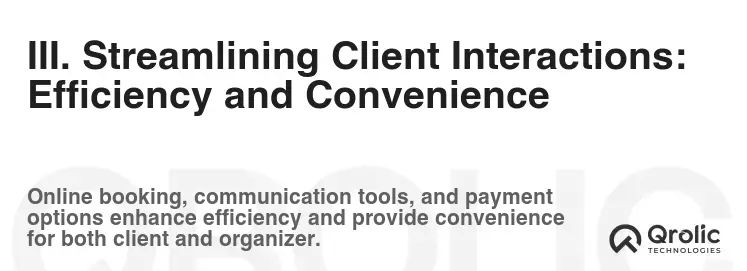
A. Contact Form: Making it Easy to Reach You
A well-designed contact form makes it easy for potential clients to reach out to you with inquiries.
- Keep it Simple: Only ask for the essential information you need, such as name, email address, phone number, and a brief message.
- Clear Call to Action: Make it clear what you want visitors to do, such as “Get a Free Quote” or “Schedule a Consultation.”
- Mobile-Friendly: Ensure your contact form is mobile-friendly and easy to fill out on a smartphone.
- Confirmation Message: Display a confirmation message after the form is submitted to let visitors know that their message has been received.
- Spam Protection: Implement spam protection to prevent unwanted submissions.
B. Online Scheduling: Booking Appointments with Ease
Online scheduling allows potential clients to book appointments directly through your website, saving you time and hassle.
- Integration with Calendar: Integrate your online scheduling system with your Google Calendar or other calendar app to avoid double-booking.
- Customizable Availability: Set your availability and block out times when you’re not available.
- Automated Reminders: Send automated email and text message reminders to clients to reduce no-shows.
- Payment Integration: Integrate your online scheduling system with a payment processor to collect payments upfront.
- Multiple Service Options: Allow clients to book different types of services online, such as consultations, decluttering sessions, and organizing projects.
C. Client Forms: Gathering Information Efficiently
Digitizing client forms streamlines the onboarding process and allows you to gather essential information efficiently.
- Customizable Forms: Create custom forms to collect the specific information you need from each client.
- Secure Data Storage: Ensure that client data is stored securely and protected from unauthorized access.
- Integration with CRM: Integrate your client forms with a CRM system to automate your workflow and track client interactions.
- Examples of Client Forms:
- Initial Consultation Form: Collect information about the client’s needs, goals, and budget.
- Project Agreement Form: Outline the scope of the project, the terms of service, and the payment schedule.
- Client Feedback Form: Gather feedback from clients after the project is completed to improve your services.
- Accessibility: Make sure client forms are accessible to users with disabilities, adhering to WCAG guidelines.
D. Payment Options: Providing Flexible Payment Methods
Offering a variety of payment options makes it easier for clients to pay for your services.
- Credit Card Payments: Accept credit card payments through a secure payment gateway.
- Online Payment Platforms: Offer popular online payment platforms like PayPal and Venmo.
- Payment Plans: Consider offering payment plans to make your services more affordable.
- Clear Payment Terms: Clearly outline your payment terms in your project agreement.
- Invoicing System: Use an invoicing system to track payments and send invoices to clients.
IV. Optimizing for Success: Long-Term Growth and Maintenance
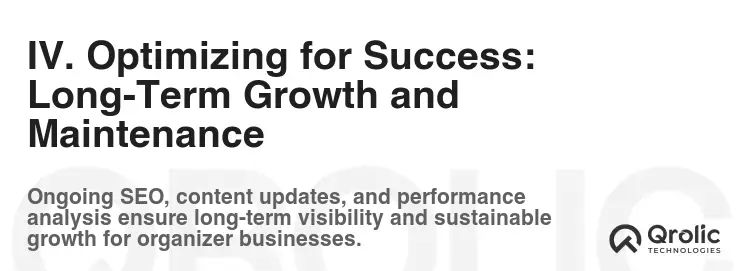
A. Website Analytics: Tracking Performance and Making Data-Driven Decisions
Website analytics tools like Google Analytics provide valuable insights into your website’s performance.
- Track Website Traffic: Monitor the number of visitors to your website and where they’re coming from.
- Analyze User Behavior: Understand how visitors are interacting with your website, such as which pages they’re visiting and how long they’re staying on each page.
- Measure Conversion Rates: Track the number of visitors who are converting into leads and clients.
- Identify Areas for Improvement: Use analytics data to identify areas where you can improve your website’s performance.
- Set Goals and Track Progress: Set specific goals for your website and track your progress over time.
B. Mobile Optimization: Catering to On-the-Go Users
With the majority of internet users accessing websites on their smartphones, mobile optimization is crucial.
- Responsive Design: Ensure your website uses a responsive design that adapts to different screen sizes.
- Fast Loading Speed: Optimize your website for fast loading speed on mobile devices.
- Easy Navigation: Make it easy for mobile users to navigate your website and find the information they’re looking for.
- Touch-Friendly Design: Use a touch-friendly design with large buttons and links that are easy to tap on a smartphone.
- Mobile-Specific Content: Consider creating mobile-specific content that is tailored to the needs of mobile users.
C. Website Security: Protecting Your Data and Your Clients’ Information
Website security is essential for protecting your data and your clients’ information.
- SSL Certificate: Install an SSL certificate to encrypt data transmitted between your website and visitors’ browsers.
- Strong Passwords: Use strong passwords for your website and hosting accounts.
- Regular Backups: Back up your website regularly to protect against data loss.
- Security Plugins: Use security plugins to protect your website from malware and hacking attempts.
- Keep Software Up-to-Date: Keep your website software, including your CMS, plugins, and themes, up-to-date with the latest security patches.
D. Regular Content Updates: Keeping Your Website Fresh and Relevant
Regular content updates are essential for keeping your website fresh, relevant, and engaging.
- Blog Regularly: Publish new blog posts regularly to attract new visitors to your website and establish yourself as an expert.
- Update Service Pages: Keep your service pages up-to-date with the latest information and pricing.
- Add New Projects to Your Portfolio: Showcase your latest work by adding new projects to your portfolio.
- Refresh Visuals: Update your website’s visuals with new photos and videos to keep it looking fresh and modern.
- Review and Update Content: Regularly review and update your website’s content to ensure it’s accurate, relevant, and optimized for search engines.
V. Partnering for Success: Qrolic Technologies

Building and maintaining a successful website requires expertise in design, development, and marketing. Partnering with a professional web development company like Qrolic Technologies (https://qrolic.com/) can help you achieve your online goals.
Why Choose Qrolic Technologies?
Qrolic Technologies offers a comprehensive suite of website services, including:
- Website Design and Development: Creating visually appealing and user-friendly websites that are tailored to your specific needs.
- SEO Optimization: Optimizing your website for search engines to improve your online visibility.
- Content Marketing: Creating valuable and engaging content that attracts new visitors to your website.
- Social Media Marketing: Managing your social media presence to build brand awareness and generate leads.
- Website Maintenance and Support: Providing ongoing maintenance and support to ensure your website is always running smoothly.
Qrolic Technologies understands the unique needs of home organizers and can help you create a website that showcases your expertise, attracts new clients, and grows your business. They can assist you in implementing all the features discussed in this article, from creating a compelling project showcase to designing effective client forms and optimizing your website for relevant keywords.
Conclusion: Your Website – A Powerful Asset for Growth
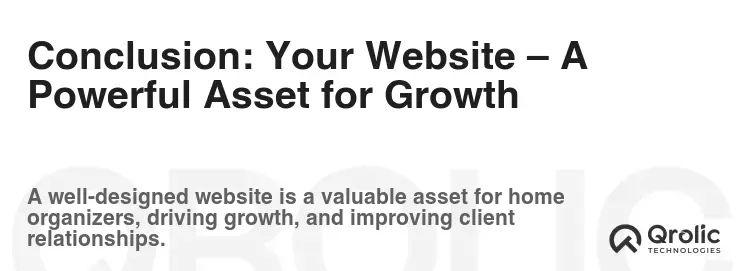
In conclusion, a well-designed and strategically optimized website is an indispensable tool for home organizers seeking to thrive in today’s competitive market. By implementing the essential features outlined in this article, you can create a powerful online presence that attracts your ideal clients, showcases your expertise, streamlines client interactions, and drives long-term growth. Remember, your website is more than just a digital brochure; it’s your 24/7 ambassador, tirelessly working to build your brand, generate leads, and transform houses into homes. Embrace the power of a great website, and watch your home organizing business flourish.
